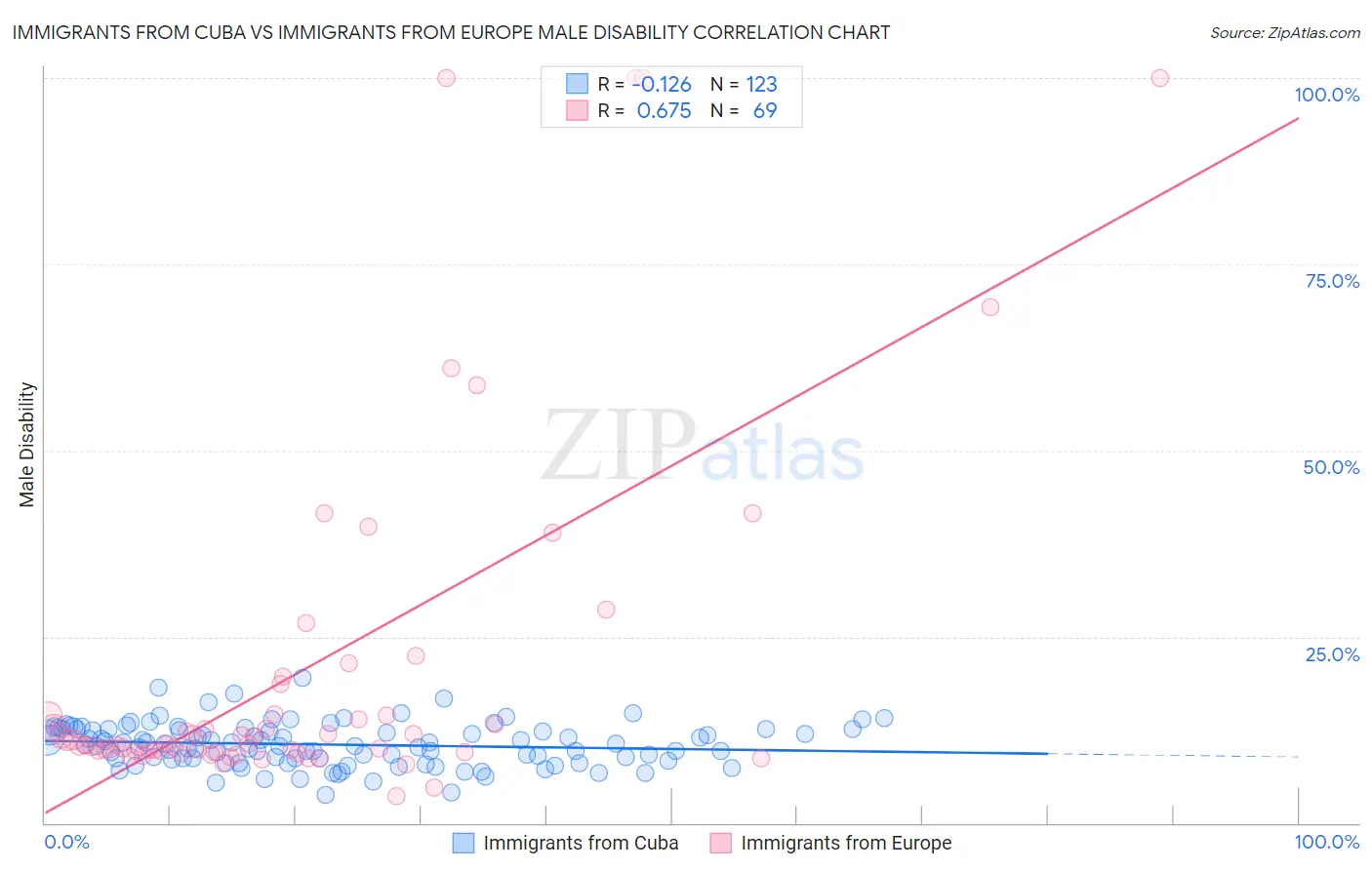Immigrants from Cuba vs Immigrants from Europe Male Disability
COMPARE
Immigrants from Cuba
Immigrants from Europe
Male Disability
Male Disability Comparison
Immigrants from Cuba
Immigrants from Europe
10.9%
MALE DISABILITY
90.2/ 100
METRIC RATING
118th/ 347
METRIC RANK
11.0%
MALE DISABILITY
82.0/ 100
METRIC RATING
137th/ 347
METRIC RANK
Immigrants from Cuba vs Immigrants from Europe Male Disability Correlation Chart
The statistical analysis conducted on geographies consisting of 325,990,586 people shows a poor negative correlation between the proportion of Immigrants from Cuba and percentage of males with a disability in the United States with a correlation coefficient (R) of -0.126 and weighted average of 10.9%. Similarly, the statistical analysis conducted on geographies consisting of 547,240,570 people shows a significant positive correlation between the proportion of Immigrants from Europe and percentage of males with a disability in the United States with a correlation coefficient (R) of 0.675 and weighted average of 11.0%, a difference of 1.0%.

Male Disability Correlation Summary
| Measurement | Immigrants from Cuba | Immigrants from Europe |
| Minimum | 3.8% | 3.6% |
| Maximum | 19.5% | 100.0% |
| Range | 15.7% | 96.4% |
| Mean | 10.5% | 20.7% |
| Median | 10.5% | 10.7% |
| Interquartile 25% (IQ1) | 8.6% | 9.6% |
| Interquartile 75% (IQ3) | 12.6% | 16.6% |
| Interquartile Range (IQR) | 4.0% | 7.0% |
| Standard Deviation (Sample) | 2.9% | 23.7% |
| Standard Deviation (Population) | 2.8% | 23.5% |
Demographics Similar to Immigrants from Cuba and Immigrants from Europe by Male Disability
In terms of male disability, the demographic groups most similar to Immigrants from Cuba are Armenian (10.9%, a difference of 0.0%), Eastern European (10.9%, a difference of 0.080%), Immigrants from Africa (10.9%, a difference of 0.11%), Immigrants from South Eastern Asia (10.9%, a difference of 0.15%), and Immigrants from Ghana (10.9%, a difference of 0.17%). Similarly, the demographic groups most similar to Immigrants from Europe are Immigrants from Costa Rica (11.0%, a difference of 0.080%), Trinidadian and Tobagonian (11.0%, a difference of 0.13%), Bhutanese (11.0%, a difference of 0.14%), Ugandan (11.0%, a difference of 0.19%), and Immigrants from Fiji (11.0%, a difference of 0.21%).
| Demographics | Rating | Rank | Male Disability |
| Eastern Europeans | 90.6 /100 | #117 | Exceptional 10.9% |
| Immigrants | Cuba | 90.2 /100 | #118 | Exceptional 10.9% |
| Armenians | 90.1 /100 | #119 | Exceptional 10.9% |
| Immigrants | Africa | 89.4 /100 | #120 | Excellent 10.9% |
| Immigrants | South Eastern Asia | 89.2 /100 | #121 | Excellent 10.9% |
| Immigrants | Ghana | 89.0 /100 | #122 | Excellent 10.9% |
| Immigrants | Czechoslovakia | 88.4 /100 | #123 | Excellent 10.9% |
| South American Indians | 88.1 /100 | #124 | Excellent 10.9% |
| Immigrants | North Macedonia | 88.1 /100 | #125 | Excellent 10.9% |
| Immigrants | Trinidad and Tobago | 86.9 /100 | #126 | Excellent 10.9% |
| Immigrants | Ukraine | 86.8 /100 | #127 | Excellent 10.9% |
| Immigrants | Latvia | 85.5 /100 | #128 | Excellent 10.9% |
| Immigrants | Philippines | 85.4 /100 | #129 | Excellent 10.9% |
| Brazilians | 85.4 /100 | #130 | Excellent 10.9% |
| Macedonians | 84.2 /100 | #131 | Excellent 11.0% |
| Immigrants | Fiji | 84.0 /100 | #132 | Excellent 11.0% |
| Ugandans | 83.9 /100 | #133 | Excellent 11.0% |
| Bhutanese | 83.4 /100 | #134 | Excellent 11.0% |
| Trinidadians and Tobagonians | 83.3 /100 | #135 | Excellent 11.0% |
| Immigrants | Costa Rica | 82.8 /100 | #136 | Excellent 11.0% |
| Immigrants | Europe | 82.0 /100 | #137 | Excellent 11.0% |